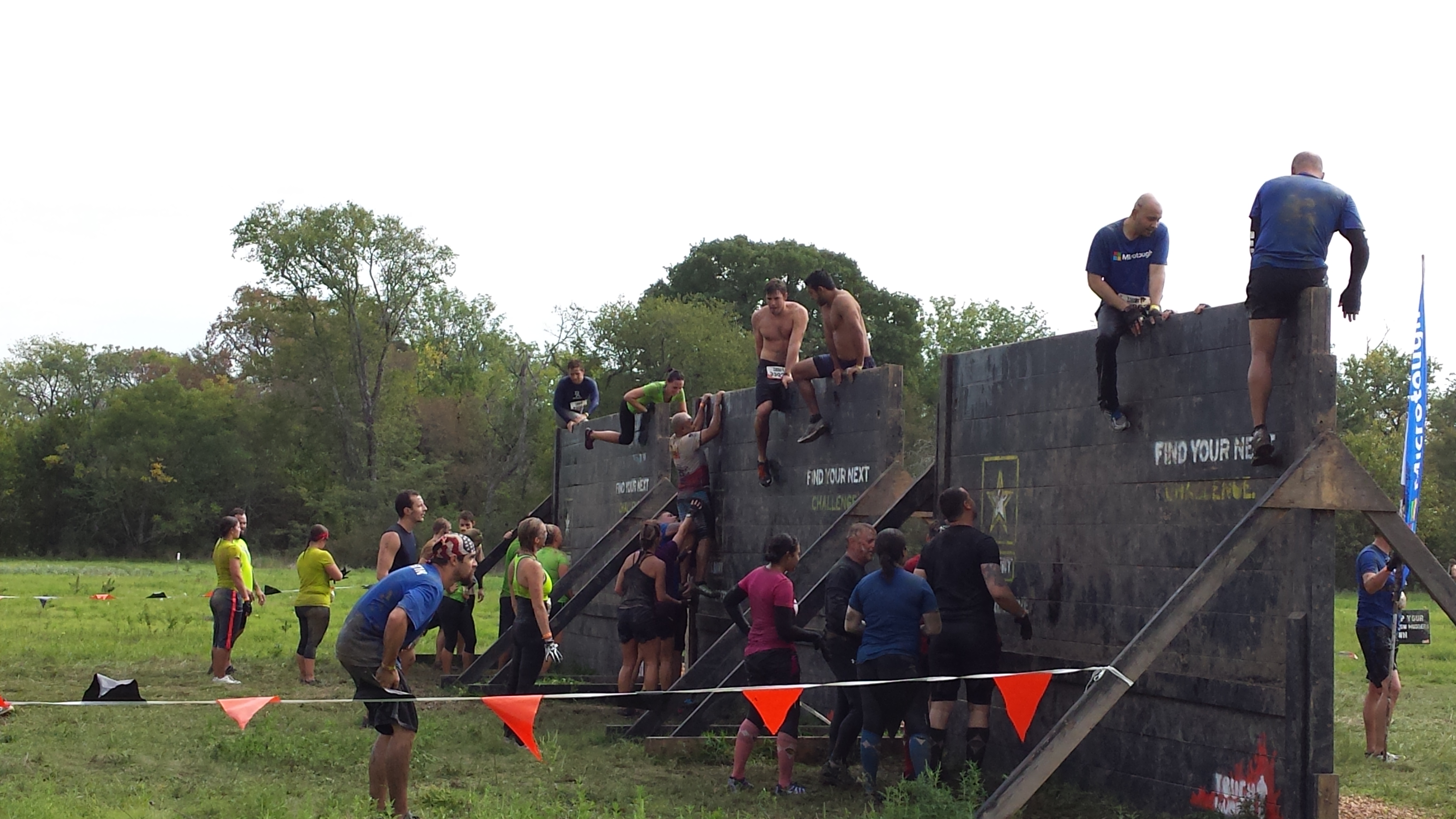By Fernando Ortiz, Contributing Writer
When it comes to mud runs, the Tough Mudder pretty much leads the pack as one of the most difficult and unique events of its kind. The Tough Mudder events are a 10+ mile obstacle course race designed by British Special forces which are held all over the U.S. and internationally. According to the Tough Mudder, well over 1 million people have participated.
Leading up to the race: Registration usually opens one year from the scheduled event date with early bird pricing and higher chances of getting early waves. If you are trying to save some money, you’ll want to sign up as early as possible. Prices usually start around $60-$70 with price hikes occurring every few months or so and can reach the $200+ price range if you wait until the week of the event. There is also a $14 insurance fee which is mandatory and standard for all races of this type. Your registration fee goes toward paying for construction materials, venue rental, lifeguards, medics, water, bananas, finisher t-shirt, headband, pictures, beer, and donations towards the Wounded Warrior project. The Tough Mudder website provides a wealth of information about the obstacles, tips for training, an online community, and gear for purchase. The 2015 race is October 3-4 and you can learn more here.
Registration is pretty simple and straightforward. Eventbrite is used to manage your account which is great for communicating with your team, recruit team members, change start times, and fundraise for the Wounded Warrior Project. Unlike regular runs where spectators can just go stand on a street and watch you pass by, the Tough Mudder charges $20 for spectators. I’ll touch back on what the spectator pass includes and why I actually like it.
Training: Everyone trains differently, but I will go into what I do in preparation for a Tough Mudder. For these types of races you need to work on being able to run and having the strength to handle the obstacles.
I begin about three months before the event. I clock in a 1-2 miles three times a week and work my way up to 3-6 miles and continue to increase it as the weeks go by. My long runs go up to 14 miles but I don’t reach that distance until a week or two before the event. I mix my runs between regular road running and trail running. Believe me, running on nice and even concrete is totally different from running on muddy and uneven trails. A pair of good trail or off-road running shoes will be your best friend in this event. Not to say you can’t do it with regular running shoes, but you will fall and slip and that can lead to sprained ankles along with cuts and bruises. There are many different brands that make shoes that can handle these types of conditions and since everyone has different feet, I recommend you shop around and read up on multiple reviews. Some of the more popular brands are Merrell, Inov-8, Reebok and Salomon.
During the other non-running days of the week, I focus on strength training to handle the obstacles. I focus heavily on being able to do strict pulls up, push ups, and dips because from my experience, that carries over the best for a majority of the obstacles. Being able to climb over a 10-12 ft wall requires you are able to lift your body over it. The monkey bars obstacle benefits from you having the hand grip strength to hold your body weight. I have learned from previous years to shy away from doing heavy leg workouts, simply because with running, your body won’t have the time and energy to recover. One year I kept doing heavy squats and dead lifts and I ended up not being able to lift heavy or run far enough. From my experience, if you wear gloves for training, then you want to wear gloves for the event. You want to find gloves that drain water well and have exceptional grip when wet and muddy.
The week of the event, I stick to very light workouts and runs. I will probably only run once for 2-4 miles and decrease the number of sets during workouts. I also begin to drink copious amounts of water. In my first Tough Mudder, cramps kicked in and kept me from being able to run the entire event. The morning of the event, I consume an insane amounts of bananas, normally around 6-10. I strongly suggest you bring energy packs or whatever you normally take that can provide you with potassium and electrolytes during the run. I normally stuff my packs in sealable plastic bags which fit nicely into this little pocket that my racing shorts have. Some people opt to carry hydration backpacks but I tend to like carrying the least amount of gear as possible.
When it comes to gear and clothing, there are an infinite numbers of things you can choose to bring with you, but one thing is universal. Don’t wear cotton anything! I can’t emphasize just how much it would suck if you wore cotton. When it gets wet, it gets heavy and can start to chafe your skin. You want to wear moisture wicking material.
Race Day: For the Dallas Tough Mudder, you normally have to drive anywhere from one to two hours south of DFW so give yourself enough time on the day of the event. The Tough Mudder offers online registration for parking, but it usually only saves you a few dollars. I normally opt to just pay cash on-site. They offer VIP parking, but in my opinion its way overpriced and only saves you a bit of walking. The parking terrain isn’t ideal for low cars just FYI.
Walking up to the entrance you will see a waiver section that you have to sign. Next you have to find your bib number which is usually posted on boards organized by your last name. After you get your bib number, you head to the entrance, show them your ID and collect your BIB, over 21 bracelet, free beer bracelet, and check-in bag bracelet. If you didn’t bring a spectator with you, then you will most likely have to pay to check in your personal items like a change of clothes, towels, and whatever else you brought with you. This usually cost $10. From my experience, the bibs are pretty pointless because most will fall off. Most people use a permanent marker to mark their bib numbers across their faces and forearms. This is only important if you want to be able to find your pictures easily. The Tough Mudder used to charge for pictures, but this last year they began building it into the price. Normally they only take pictures at a handful of obstacles. A spectator can usually take far better pictures and at multiple obstacles. If you can convince someone to do this, it’s 20 dollars well spent.
The spectator pass is pretty unique in the Tough Mudder events because it offers the spectator to follow you around on a separate and shorter course. The spectator course is designed to allow the person to be able to walk between obstacles while the participant is running between obstacles. The majority of the fee goes towards covering the insurance fee so as a spectator you don’t get anything. It really is just an opportunity to have someone cheer on the participant and take really awesome pictures. My wife usually gets the spectator pass and it is a great morale booster. It was great seeing her waiting for me at different obstacles and cheering me on. She enjoyed it and said the course was nicely marked so she never felt like she would get lost.
Once you get passed the registration stand, you will find a bustling open courtyard area with people either preparing for the race or chugging a beer completely covered in mud and sporting a brightly colored headband. You will see people of all ages rocking outrageous costumes or team shirts with clever, often inappropriate team names. You will see a medic station, a changing station, port-a-potty section, open air shower area, food vendors, various sponsor booths, and a Tough Mudder store. It might be overwhelming at first, but there are plenty of volunteers who are very knowledgeable and friendly. Two other really important things you will see, the warm up section that leads to the starting line and the Electroshock Therapy right next to it. The Electroshock Therapy is the last obstacle and one of the most iconic for this event. You will hear the MC cracking jokes and laughing at the spectacle of people trying to cross this obstacle. You might even want to join in on the laughter but then you’ll realize that soon enough that you will be eating mud after getting zapped by the electrical wires.
Twenty minutes before your scheduled wave, they will ask you to go into the warm up section which is a short distance from the starting line. Once it’s time, you will have to move towards the start line and jump over a 4-6 ft. wooden wall. Yup… there is an obstacle just to get to the starting line. Tough Mudder usually has waves of around 100 people every 15 minutes. If you miss your start time, don’t worry, you can jump on the next one. At the start line, the MC will give you the Tough Mudder speech designed to hype you up, remind you that it’s a team event, and not to worry about your pace.
After 10+ miles and over 20 obstacles, and the final Electroshock Therapy obstacle, you’ll finish the race by crossing that long besotted finish line. Once you cross, you’ll be greeted by volunteers handing out the Tough Mudder orange headband, which is their unique version of a medal. This year, for those who have previous events, they are offering what they call Legionnaires headbands. They are uniquely colored headbands showcasing your previous accomplishments. Also, if you are a legionnaire you have to take a longer course with a few extra obstacles but you can skip the Electroshock Therapy, and you better believe I skipped it. They will also be handing out water, protein bars, and bananas. There is a booth usually next to the finish line where you can pick up your free Tough Mudder finisher t-shirt. I received my UnderArmour workout shirt and then I grab that well-deserved beer after. At this point, you are starting to cool down and you have the option to go shower off as much of the mud as possible. Trust me, you won’t get it all off until you get home and shower a couple of times.
Difficulty Level: I love the Tough Mudder events, but it definitely isn’t for everyone and especially for people who are not active. I always begin training a few months before hand and I can’t emphasize how important training can be and not something you can cram into a few weeks. As with any race/run, there are possibilities of serious injuries and deaths. You have to be vigilant of what you are doing, how your body is reacting, and opt out if you feel an obstacle is too dangerous. Heat exhaustion, blisters, and sprains seem to be what knock most people off the run. There are medics ready to help you so don’t feel shy about asking for help. On my first Tough Mudder event, I had a chunk of mud splash right in my eye and I couldn’t take it out, the medics quickly flushed my eye out and I was on my way. Lucky for me it wasn’t more serious. There are usually 5-6 well stocked water stations so make sure to drink up and if necessary rest up. I always recommend people to run on a consistent basis leading up to the event and follow some type of strength training regiment. You could get by without any of this, but honestly you won’t enjoy the event. Some of the most physically demanding obstacles in my opinion are Everest, Funky Monkey, Hangin Tough, Berlin Wall, and Just the Tip. The Tough Mudder has funny names for their obstacles. There are other obstacles but I think those are more of a psychological challenge than physical like the Artic Enema or Boa Constrictor. You can go to their website and look at descriptions and pictures of each of these obstacles.
Loved: My favorite obstacles are the Funky Monkey, Everest, Hanging Tough and Mud Mile. What can I say, I love some of the most difficult obstacles. There are occasional signs posted throughout the course with witty statements like, “If you are huffing and puffing now, we feel sorry for your significant other” and “Remember you signed a death waiver.” The cool and outrageous costumes people wear all add to what makes the Tough Mudder so much fun. At first I didn’t understand why you would want to do this and not track your time or worry about your pace. Once I stopped worrying about these things, I had a blast and enjoyed the company of my teammates.
Hated: One of my biggest gripes with the Tough Mudder is the toilet and shower facilities. They always have plenty of portable toilets but they never keep them stocked with toilet paper or hand sanitizer. I’d definitely recommend bringing some and maybe even hand wipes or baby wipes. You’ll thank me later. I have been to multiple Tough Mudder events and it’s always an issue. I tend to do my business at the closest gas station and just hope it’s enough. As for the showers, the issue is always water pressure and in some cases you have to wait 30 minutes to an hour for them to refill the water tanks. Trying to get dry mud off with low water pressure is rather difficult so what I learned to do is bring a change of clothes and simply change into them. Sure I still have mud all over me but like I stated before, you won’t get it all off anyway.
Who came?: The Tough Mudder caters to anyone who wants to take on the challenge. You will see a good mixture of men and women participating ranging from teenagers to well seasoned individuals. Participants are encouraged to bring their families for support and there is even a children’s mini Tough Mudder course. You can sign your children up to do a mini obstacle run, usually a mile or so long with obstacles meant for children. I have never stayed to watch so I don’t know much about it, but the Tough Mudder definitely tries to be as family friendly as possible. I will say, if you are uncomfortable with men and women wearing very little clothing, then mud runs like these might be too much for you. I don’t think anyone is ever inappropriate, but some people choose to run these events in speedos.
The Takeaway: My favorite aspect of this event is the camaraderie that you build with your teammates and the fun obstacles that the Tough Mudder offers. Most of the obstacles require teamwork and even if you run it solo, there is always someone willing to help and cheer you on. The spectator pass is simply awesome. If you are like me and drag your significant other, then you will have something to look forward to between each obstacle. After every event I do, I come out with such a high, I can’t explain it.
I do want to clarify that you don’t have to be in top physical shape to enjoy this event. I only train as hard as I do because I am competitive and want to always outperform myself. You can definitely walk the entire time and if you fail an obstacle, the worst that will happen is that you probably fall into a pool of muddy water. I definitely encourage you to give it a try and if you decide you want to, you can join me next year. I always love doing Tough Mudders with large groups of people, something about knowing there are other crazies out there that make it more fun.
Fernando Ortiz is a contributing writer for Deep Fried Fit and is an engineer who loves food and physical fitness. His favorite cuisine is Thai and enjoys craft beers. He also loves going on foodie adventures with his wife and checking out new restaurants. In his spare time, you can find Fernando mountain biking, trail running, barbell strength training, kettlebell training, and bodyweight calisthenics. He is also an avid participant of obstacle course racing such as Tough Mudder and the Spartan Race series.











